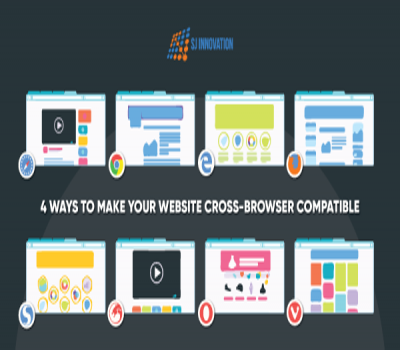4 Ways to Make Your Website Cross-Browser Compatible

Cross-browser compatibility has time and again proved to be integral to the success of any website. The objective is to guarantee easy access to all users regardless of the browser or device they're on.
When building your site to be cross-browser compatible, be sure to consider the needs of differently gifted users and persons with disabilities. Providing accessibility to such user groups ensures that the website doesn't come up differently for them.
So, does your website require a bit of rework to provide equal access to all users across all web platforms? It does if some of the visitors browsing it on thousands of different devices don't see it the same way you expect them to. In such a case, you may be keeping a significant size of your target population out of the site.
Here are practical hacks for making your website cross-browser compatible:
Keep Tabs on the Latest Web Tech Trends
As a website builder, you have to keep your fingers on the pulse of relevant technologies. There's no other way around it if you wish to use the most up-to-date design and development tools to implement or reinforce browser-compatibility.
So, identify the latest development tools, software patches and updates, libraries, and frameworks. For example, are there any MSQL upgrades you need to know about? Do you have the newest JavaScript frameworks to hand?
The latest web technologies will enable you to implement cross-browser compatibility on your website, guaranteeing uniform access across the most recent browsers and browser versions.
Test Thoroughly
Use cross-browser testing tools to thoroughly check your website for compatibility issues across multiple platforms and browsers. Be sure that every design aspect works right and appears as it should.
One potential compatibility issue you can't afford to ignore is Cascading Style Sheets (CSS), which defines the appearance of web page elements. For example, you may have noticed how HTML form buttons look different from browser to browser. Thus, it's vital that you test your web pages for styling incompatibilities like that.
Likewise, some browsers may not support certain features at all, such as Web Authentication API and overflow anchor. In that case, you may have to do away with such elements, functions, or properties, or find a universally compatible way to implement them.
Ensure Website Accessibility
Make sure your website or web application is accessible to all persons (including users with a disability). As you design for accessibility, anticipate the varying needs of users such as:
- Individuals reading your content using screen readers
- Individuals using keyboards, shortcuts, and other non-mouse techniques to access your web pages
- Individuals on older browser versions
- Users that access your site via different devices like tablets and smartphones
Other elements that can help to improve the accessibility of your website include color schemes and contrasts, closed captions in videos, and an excellent semantic structure.
You'll need to conduct an accessibility test to guarantee that your website or web application is accessible to everyone.
Design for a Pleasing Look and Feel Across All Browsers
Designing for cross-browser compatibility requires that you provide a pleasing look and feel to all users regardless of how they're accessing your website. Be sure to give special attention to the user interface (UI) and user experience (UX) requirements for all users.
For example, your web pages shouldn't be easy to navigate on Chrome but stressful to use on Firefox. Also, maintain stunning aesthetics and excellent organization of page elements across all browsers. You want to ascertain that your users will love the website, no matter their favorite platform.
Designing your website to be cross-browser compatible optimizes the UX and accessibility for all users. It ensures that you don't exclude any proportion of your target audience.

Why CRM is important


